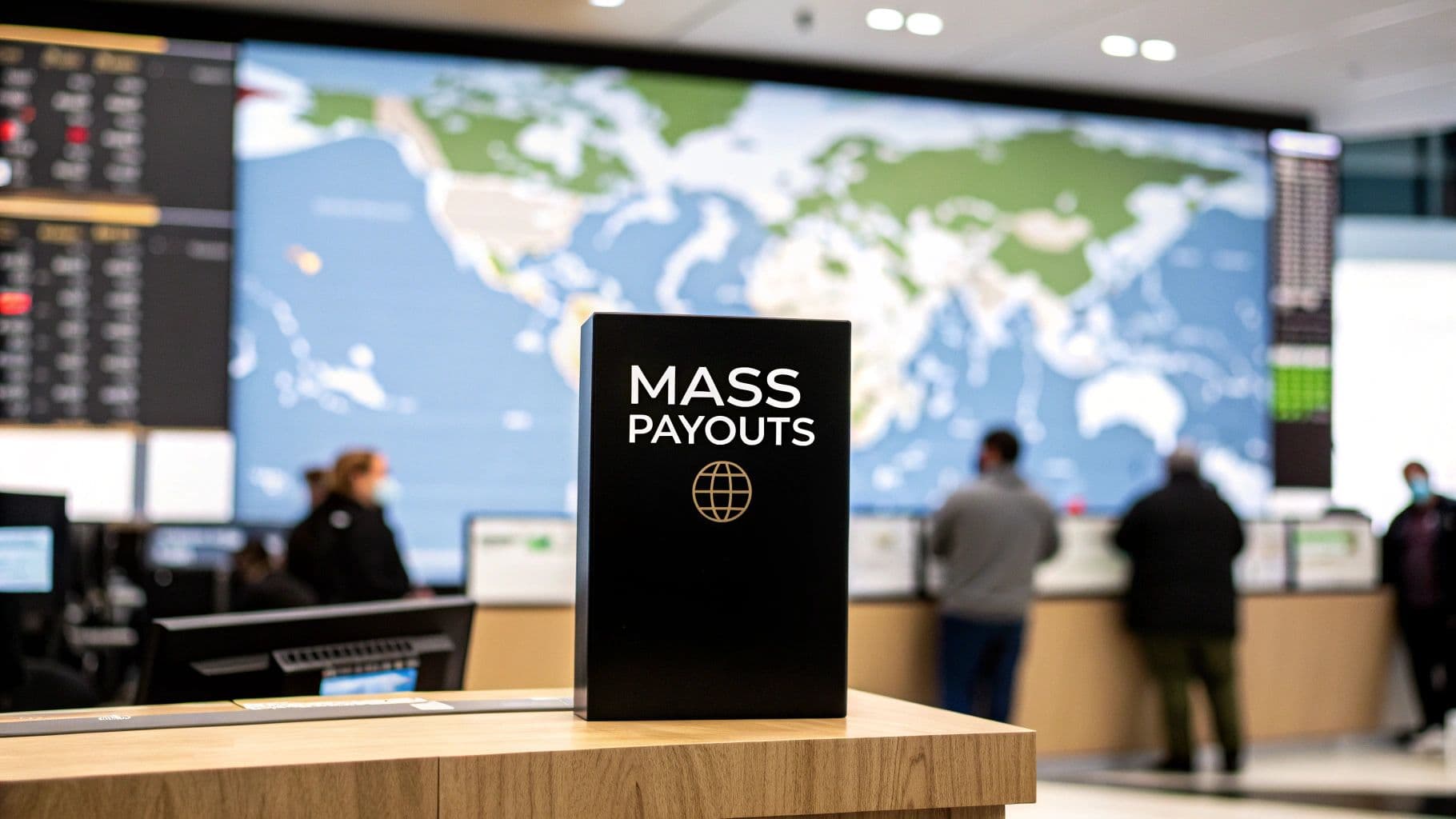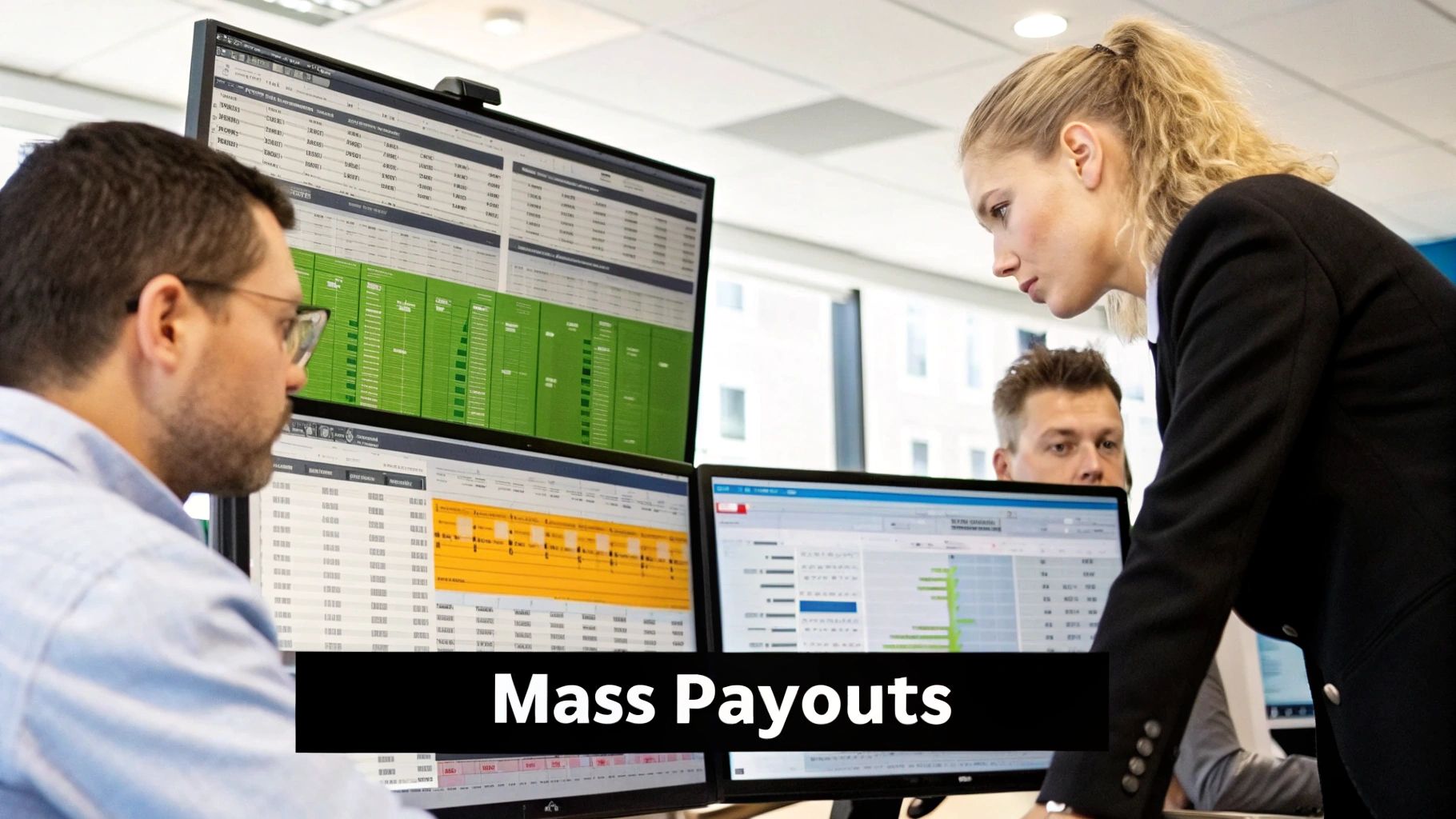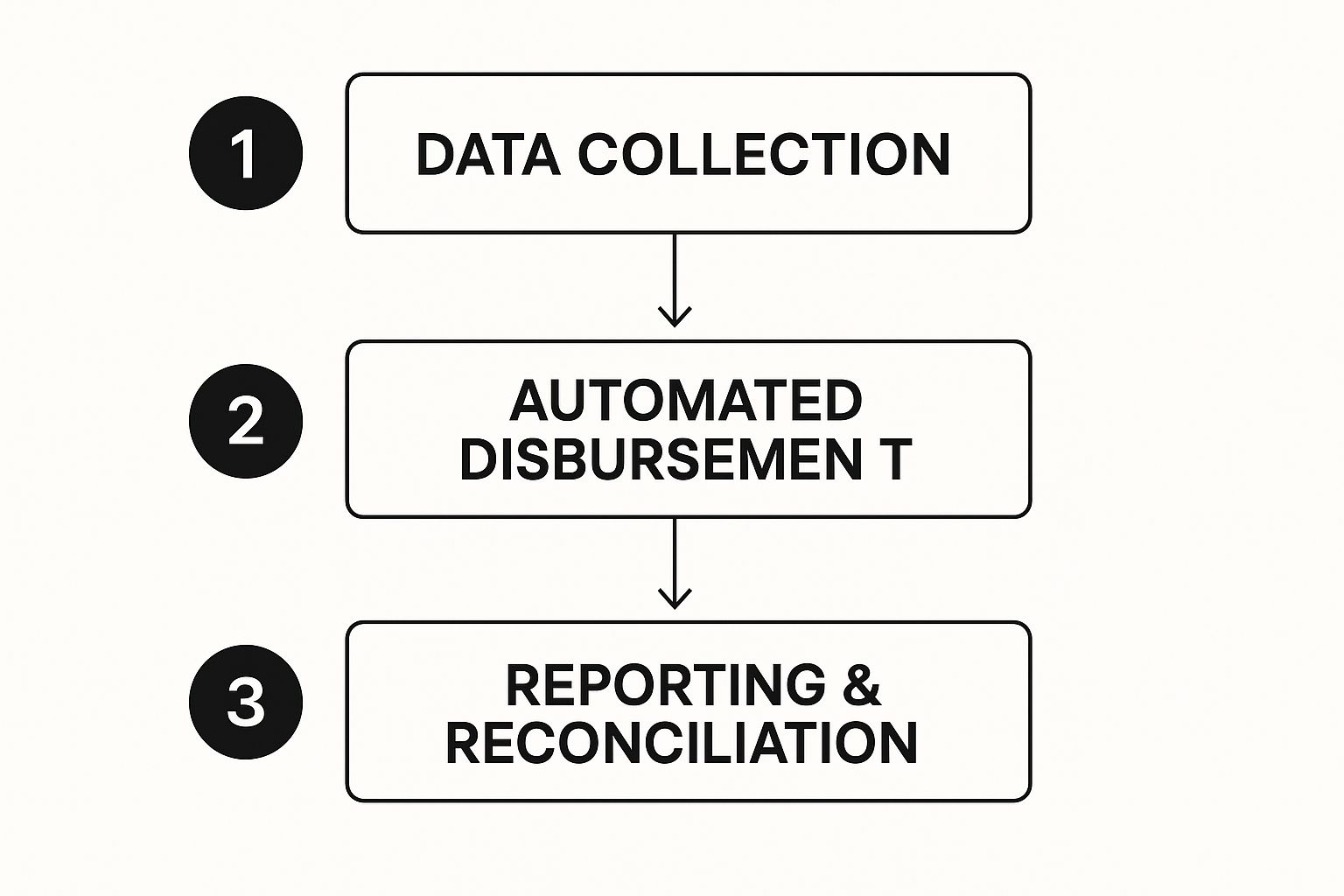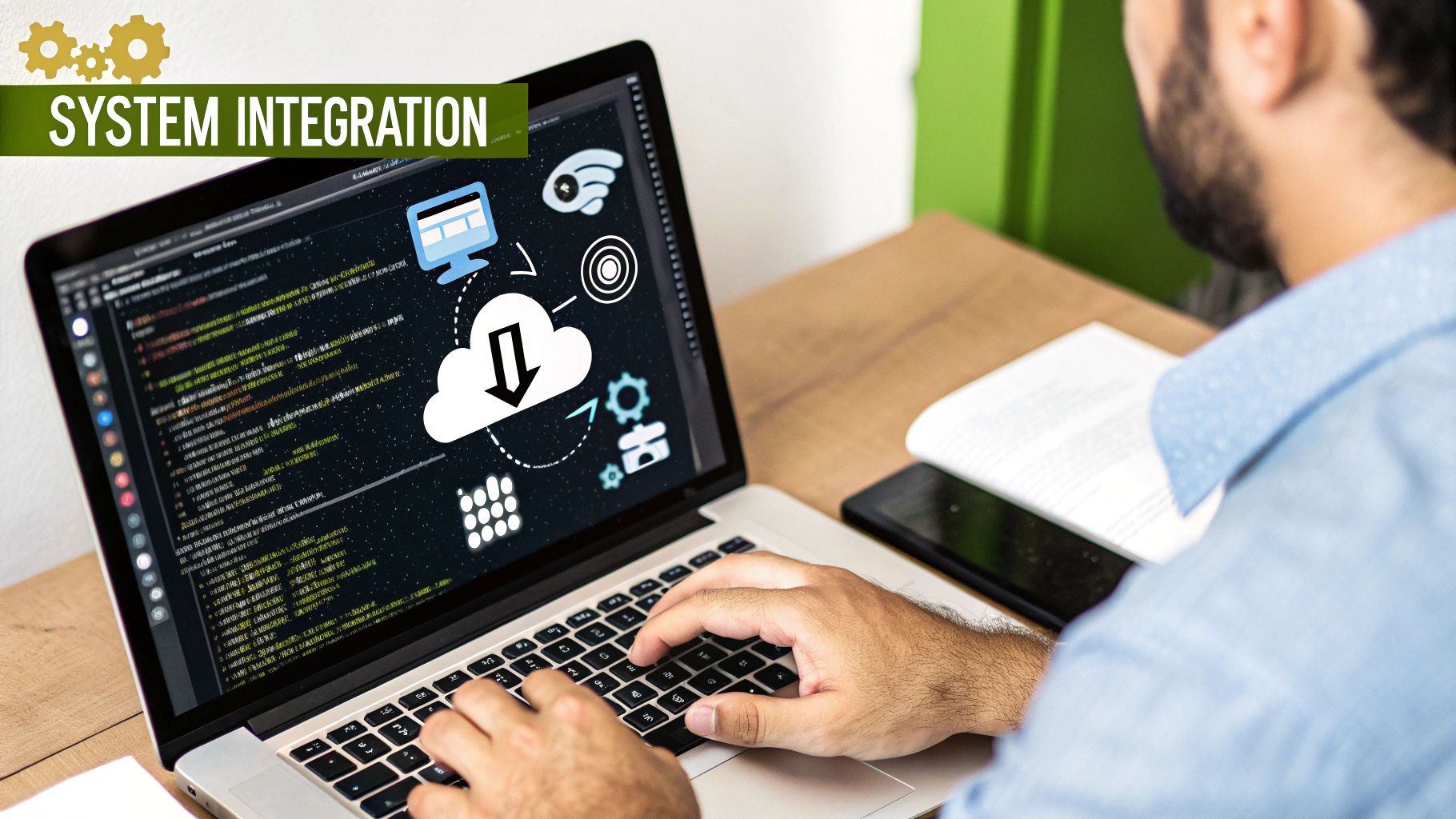
A Guide to Mass Payout Solutions
If your business relies on paying a large number of people—whether they're freelancers, affiliates, or marketplace sellers—you know the headache of managing those payments. Doing it manually with spreadsheets and individual bank transfers is not just slow; it's a recipe for errors and frustration. This is precisely where a mass payout solution comes in.
What Are Mass Payout Solutions Anyway?
Think of a mass payout solution as your company's automated payment command center. Instead of getting bogged down in the tedious work of processing each payment one by one, you can send out hundreds or even thousands of payments in a single, coordinated action.

You simply upload one set of instructions, and the platform takes over. It handles the nitty-gritty details of getting the right amount of money to the right person, in the right currency, no matter where they are in the world. For any business trying to grow, moving from manual processing to an automated system like this isn't just a convenience—it's a necessity.
The Driving Force Behind Mass Payouts
The explosion of the gig and creator economies has turned mass payout systems from a niche tool into an essential part of modern business. The market reflects this shift. Valued at roughly USD 100 billion today, the global mass payment sector is projected to surge to over USD 250 billion by 2033. This isn't surprising when you consider how many businesses now depend on a global network of contributors.
Who's using these platforms the most?
- The Gig Economy: Think of ride-sharing apps and freelance marketplaces. They need a reliable way to pay thousands of independent contractors on time, every time.
- Online Marketplaces: E-commerce sites have to manage payouts to countless sellers and vendors around the globe.
- Creator and Influencer Platforms: These platforms handle royalty and commission payments for huge numbers of content creators.
- Affiliate Marketing Networks: Their entire business model is built on distributing commissions efficiently to a wide web of affiliates.
From managing vendor payments to enabling streamlined payroll processing for SMEs, the applications are incredibly broad.
Beyond Just Sending Money
Today’s mass payout platforms offer much more than simple money transfers. They've evolved into complete systems designed to manage everything from compliance and security to the overall payee experience. A good platform will automate tax form collection, verify identities to combat fraud, and give payees a portal to manage their own payment details. For a closer look at how these features come together, see how it works with https://blockbee.io/payouts.
By handling the complexities of global compliance and offering multiple payment methods, these solutions enable businesses to maintain healthy, trust-based relationships with their payees and stay competitive on a global scale.
To put it all into perspective, here's a quick summary of the advantages these solutions bring to the table.
Key Benefits of Mass Payout Solutions at a Glance
| Benefit Category | Description | Impact on Business |
|---|---|---|
| Operational Efficiency | Automates the entire payment process, from instruction to settlement, eliminating manual data entry. | Frees up finance teams to focus on strategic tasks instead of repetitive administrative work. |
| Cost Reduction | Significantly lowers transaction fees compared to individual wire transfers and reduces overhead for manual processing. | Improves profit margins and makes scaling the business more affordable. |
| Global Reach | Enables seamless payments to recipients in multiple countries and currencies from a single platform. | Opens up access to a global talent pool and new international markets. |
| Enhanced Security | Implements robust fraud detection, identity verification, and data encryption to protect funds. | Minimizes financial risk and protects the company's reputation. |
| Improved Compliance | Automates tax form collection (like W-9s/W-8s) and adheres to international payment regulations. | Reduces the risk of penalties and ensures the business stays compliant with complex legal rules. |
| Payee Satisfaction | Offers recipients multiple payment options (bank transfer, crypto, etc.) and provides transparency through a self-service portal. | Builds stronger, more loyal relationships with freelancers, affiliates, and partners. |
Ultimately, adopting a mass payout solution is about future-proofing your payment operations. It equips your business with the agility and reliability needed to thrive in an increasingly interconnected global economy.
How Mass Payouts Work Behind the Scenes
Ever wondered how a single payment instruction magically turns into hundreds of individual deposits landing in accounts all over the world? It’s less like magic and more like a finely tuned logistics operation. Think of your batch of payments as a massive shipment of packages; the mass payout solution is the central hub that sorts, scans, and routes every single one to its correct destination without a hitch.
This whole operation happens in a few key stages, all designed to make sure every payment is accurate, secure, and above board. It kicks off with gathering the right information and wraps up with everything neatly reconciled, turning what could be a massive administrative headache into a simple, automated task.
The infographic below breaks down this core three-step process, from collecting payee data to sending the funds and getting the final reports.

As you can see, modern mass payout solutions aren't just about sending money. They weave together payee management, payment execution, and financial oversight into one seamless workflow.
Payee Onboarding and Data Collection
The whole journey starts by getting the payee’s information, and getting it right is critical to avoid failed payments later. Instead of the old, insecure method of chasing down bank details over email, a good platform gives your recipients a secure, self-service portal.
Through this portal, your payees can:
- Enter their personal details like their name and address.
- Pick how they want to get paid, whether it's a direct bank transfer, a digital wallet, or something else.
- Upload necessary tax forms (like W-9s or W-8s) directly and securely.
This hands-off approach doesn't just make life easier for your payees; it puts the responsibility for accurate data squarely on their shoulders, which dramatically cuts down on your team's admin work. The platform then instantly validates everything they enter.
Automated Validation and Error Prevention
Once the data is in, the system acts like a relentless quality control inspector. Before a single cent moves, the platform runs a battery of automated checks to catch the common mistakes that plague manual payment processes.
For example, the system will instantly check if a bank account number is in the right format for a specific country or if a SWIFT code is actually valid. This step is a game-changer. Industry analysis reveals that these automated checks can slash payment errors by as much as 66%. By catching problems before the payment is sent, you avoid the frustrating and expensive process of chasing down and fixing failed transactions.
A core function of a reliable mass payout solution is to preemptively solve problems. Automated validation turns the reactive, stressful task of fixing payment errors into a proactive, seamless process that safeguards your funds and payee relationships.
Secure Processing and Settlement
With all the information double-checked and verified, the platform is ready to send the money. All you have to do is fund a single master account, and the system takes care of the rest. It intelligently routes each payment through the best channel, whether that’s a local ACH network, an international wire, or even crypto rails.
During this stage, the platform also handles all the currency conversions. It automatically changes the funds into the recipient's local currency, often locking in better exchange rates than you'd get from a traditional bank. The money then settles in the payee's chosen account. The entire process is tracked from start to finish, and both you and your recipient get an automatic heads-up once the payment is complete, giving everyone total transparency.
What to Look for in a Top-Tier Payout Platform
Picking a mass payout solution can feel like you're drowning in options. But here’s the secret: it’s not about finding the platform with the longest feature list. It’s about zeroing in on the core tools that solve the real-world headaches of paying people all over the globe.
A truly great platform is more than a simple transaction tool; it’s a complete ecosystem for managing your payees. It turns your payment process from a necessary evil into a genuine asset for growth.

So, let's cut through the noise. These are the non-negotiable features that separate the best from the rest. Think of them as the things that will save you time, slash your risk, and ultimately keep your global partners happy.
Global Payment and Currency Support
This is the absolute baseline. If a platform can't pay people where they are, in a way that works for them, it's a non-starter. The platform's real value is in its reach.
Here's what that looks like in practice:
- Diverse Payment Methods: Your platform has to go beyond basic bank transfers. Look for support for ACH, SEPA, and wire transfers, but also for digital wallets and even crypto. This kind of flexibility means you can pay a developer in Berlin just as easily as a creator in Manila.
- Multi-Currency Smarts: The system needs to handle currency conversions without you having to think about it. It should be automatic and transparent. This means your finance team isn't pulling their hair out, and your recipients get the right amount in their local currency without any nasty surprises.
When a platform gets this right, it effectively erases borders from your payment operations. You can bring on talent from anywhere without worrying about the logistical nightmare of actually paying them.
Automated Tax and Regulatory Compliance
Trying to manually collect tax forms and keep up with international rules is a recipe for disaster. It’s a massive, error-prone job. Modern payout solutions take this entire burden off your shoulders.
A robust platform acts as your compliance co-pilot. It should automatically collect the right tax forms—like W-9s for U.S. contractors or W-8s for international ones—right when they sign up. It also needs to run essential identity checks to meet KYC (Know Your Customer) and AML (Anti-Money Laundering) standards.
This kind of built-in automation saves hundreds of hours and dramatically lowers your risk of facing expensive fines. As your business grows, your compliance framework grows with it, giving you the freedom to focus on what really matters.
Robust API and System Integration
Your payout platform can't be an island. For it to be truly efficient, it needs to talk to the other financial software you use every day. That’s where a powerful, well-documented API comes in.
A solid API lets you:
- Sync Payment Data: It creates a bridge between the payout platform and your accounting software (think QuickBooks or Xero) or ERP system.
- Eliminate Manual Entry: This connection means no more mind-numbing copy-and-pasting, which is where most mistakes happen.
- Speed Up Reconciliation: Closing the books at the end of the month becomes ridiculously fast and accurate.
When you think about the tech that powers mass payout solutions, it's helpful to see how they fit in with the top accounting automation tools on the market. This integration is what creates a smooth, automated financial workflow from start to finish.
Advanced Security and Technology
Last but not least, the technology itself has to be rock-solid and built for the future. The best platforms are already using AI and machine learning for things like flagging suspicious activity, validating invoices automatically, and making global tax compliance even easier.
Essential security features include end-to-end data encryption and two-factor authentication, along with compliance with major global security standards.
By focusing on these four areas—global reach, automated compliance, seamless integration, and advanced security—you can choose a mass payout solution that doesn’t just solve today's problems but is ready to support you for years to come.
Choosing the Right Payout Solution for Your Business
Picking a provider for your mass payouts is less like buying software and more like choosing a long-term business partner. Get it right, and you unlock global growth and operational freedom. Get it wrong, and you're stuck with costly errors, unhappy recipients, and compliance nightmares. The smart choice starts with a frank look at what your business actually needs.
Before you sit through a single sales demo, take a moment to get a handle on your own payment ecosystem. How many payments are you sending each month? Are you paying people in a handful of countries or all over the world? This quick internal audit will give you a solid baseline for evaluating what different providers are bringing to the table.
Once you have that clarity, you can start sizing up potential partners against the criteria that truly matter. This is about more than just a feature list; it's about finding a solution that fits your operational model, your team's technical skills, and your vision for the future.
Assess Your Core Payout Needs
First things first, map out your payment volumes and where in the world you're sending money. A platform built for a startup paying ten local freelancers is a completely different beast from one designed for an enterprise managing thousands of international vendors.
Start by asking yourself these critical questions:
- Payment Volume: Are we talking 50 payments a month or 5,000? Scalability is everything, and the fee structure needs to make sense at your scale.
- Geographic Footprint: Do you just need to pay people in North America, or are you looking for solid support across Asia, Europe, and Africa?
- Recipient Types: Who are you paying? Gig workers, marketplace sellers, and affiliates all have different expectations and payment needs.
- Technical Resources: Do you have a development team ready to dive into a powerful API, or do you need a simple dashboard that works straight out of the box with zero coding?
An honest assessment here will instantly help you weed out solutions that are a poor fit, saving you a ton of time and effort down the road.
Demystify the Fee Structures
Pricing for mass payout services can be notoriously complex, and it’s easy to get snagged by hidden costs. You have to look past the advertised transaction fee and figure out the total cost of ownership. Providers usually stick to a few common models, and knowing how they work is crucial.
A transparent fee structure is the hallmark of a provider you can trust. If you can't get a clear, straightforward answer on currency conversion rates, transfer fees, and other potential charges, consider it a major red flag.
Look for common costs like per-transaction fees, monthly platform subscriptions, and markups on currency conversions. Don't be shy about asking direct questions about hidden charges, like fees for failed payments or extra costs for priority support. You need the complete financial picture before you commit.
Compare Different Types of Providers
Not all mass payout solutions are created equal. They typically fall into a few distinct categories, each designed for different business needs. Understanding these models helps you match a provider’s strengths to your company’s operational style.
Some providers offer a do-it-all dashboard, others give you a powerful API to build with, and a new wave specializes in crypto. Each approach has its place.
The table below breaks down these common models to help you see where your business might fit.
Comparing Types of Mass Payout Solutions
This table compares three primary models of mass payout providers to help businesses identify which type best fits their specific operational needs and technical capabilities.
| Solution Type | Best For | Key Strengths | Potential Drawbacks |
|---|---|---|---|
| All-in-One Platforms | Businesses seeking a user-friendly, comprehensive system with minimal technical setup. | Easy-to-use dashboards, integrated compliance features, and broad functionality out of the box. | Can be less flexible for custom workflows and may have higher subscription fees. |
| API-First Solutions | Tech-savvy companies with development resources that need deep, custom integrations. | Unmatched flexibility to embed payments into your existing products and financial systems. | Requires technical expertise to implement and manage; may lack a user-friendly interface. |
| Crypto Payout Specialists | Companies operating in the Web3 space or those needing to pay a global, unbanked workforce. | Instant cross-border settlement, lower transaction fees, and access to global recipients without traditional banks. | Currency volatility can be a concern, and regulatory landscapes are still evolving. |
By taking the time to understand your needs, scrutinize the costs, and see how different providers operate, you can move past a superficial feature comparison. This methodical approach will help you choose a true partner—one that not only solves today's payment headaches but also supports your growth for years to come.
Getting Your Payout System Right: Best Practices
Choosing the right tool is a great first step, but how you implement and manage it is what truly makes a difference. A thoughtful strategy can transform your mass payout solution from a simple operational tool into a powerful engine for building trust and streamlining your business. Getting it right from the start helps you sidestep common headaches and ensures a smooth ride for both your team and your recipients.

Think of this as your playbook for success. Following these guidelines is key to guaranteeing accuracy, beefing up security, and building solid relationships with everyone you pay.
Design a Painless Onboarding Process
First impressions matter. The first time a payee interacts with your payment system sets the stage for your entire relationship. If it’s clunky or confusing, you’re just creating frustration and more work for everyone. The goal is a simple, self-service experience that lets recipients handle their own information with ease.
This means giving them a clean, branded portal where they can:
- Enter payment details confidently, without worrying about data security.
- Pick their preferred way to get paid from the options you offer.
- Upload tax documents directly, instead of emailing sensitive files back and forth.
A slick onboarding process doesn't just cut down on your team's workload; it also slashes the data entry mistakes that cause payments to fail. It tells your payees you respect their time and take their security seriously.
Be Proactive and Clear with Communication
When it comes to money, nobody likes uncertainty. Your recipients should never be left guessing when their payment will arrive. Proactive communication is the bedrock of trust and the single best way to reduce the number of support tickets your team has to field.
Being upfront about payment schedules and any unexpected delays isn't just good manners—it’s essential for keeping your payees happy. When people know what to expect, they feel valued and secure working with you.
Set up automated notifications to keep people in the loop. For a closer look at what this can do, you can find out more about how https://blockbee.io/blog/post/automated-payouts-now-available-for-all-blockbee-users. Even simple updates—like "your payment has been sent" and "it should arrive by X date"—can make a world of difference.
Make Security Your Top Priority
Let's be clear: when you're handling financial data, security is not optional. Protecting sensitive information and stopping fraud has to be at the core of your operations. Strong security habits shield both your business and your payees from potentially devastating financial and reputational harm.
Start with these foundational security practices:
- Use Role-Based Access Control (RBAC): Not everyone needs the keys to the kingdom. Limit system permissions based on what a person actually needs to do their job. An accountant might prepare a payment run, for example, but only a finance manager should have the power to approve and send it.
- Require Strong Authentication: Make two-factor authentication (2FA) mandatory for anyone logging into the payout platform. It’s a simple step that adds a crucial security layer on top of a password.
- Review Audit Logs Regularly: Get into the habit of checking the system's activity logs. These logs give you a clear trail of who did what and when, making it much easier to catch suspicious activity before it escalates into a real problem.
The Future of Global Mass Payments
The world of payments doesn't stand still, and for any business handling payouts, keeping up isn't just an advantage—it's essential. We're not talking about small tweaks here. The future is a complete rethink of how money moves, focusing on speed, accessibility, and smarter technology. As the people you pay expect more, the mass payout solutions supporting them have to deliver.
What's really pushing this change? The demand for instant everything. Gig workers, freelancers, and marketplace sellers simply don't accept waiting days to get paid anymore. This shift toward real-time payments is forcing platforms to find quicker, more direct ways to send money across the globe. Instant settlement is the new baseline.
The Rise of Alternative Payment Rails
For a long time, traditional banking systems were the only game in town. Not anymore. Alternative payment methods, especially cryptocurrencies, are carving out a significant role in making international transactions far less of a headache. They provide a direct route that sidesteps the slow, expensive, and often convoluted correspondent banking network.
This is a game-changer for paying people in regions where the financial infrastructure isn't as robust. Using digital currencies, businesses can send funds fast and directly, opening up a truly global talent pool. You can dive deeper into this topic by exploring our guide on the top cross-border payment solutions today.
The future of payouts is defined by choice. Success will depend on a platform's ability to offer a diverse menu of payment options—from local bank transfers to digital wallets and crypto—that meets recipients where they are.
AI and Intelligent Routing
It’s not just about new payment methods; artificial intelligence (AI) is quickly becoming the brain behind modern payout systems. AI algorithms can now analyze countless payment routes on the fly, automatically picking the cheapest and fastest path for every single transaction. This kind of intelligent routing is a huge deal for cutting down on fees and delays.
On top of that, AI is making fraud detection incredibly sharp. By learning what normal payment activity looks like, these systems can spot and flag strange behavior instantly. This protects businesses from increasingly sophisticated scams and keeps the entire payment process secure.
This is all happening as the global payments industry continues to be a powerhouse. Payments are still the most valuable corner of the finance world, delivering an average return on equity of 18.9%. While some revenue growth might cool off, income from transactions is expected to climb by about 4% annually, fueled by these very innovations. If you want to dig into the numbers, McKinsey.com offers some great insights into the global payments landscape. Building a future-ready payment strategy means getting on board with these trends, ensuring your operations are solid today and ready for whatever comes next.
Got Questions About Mass Payouts? We've Got Answers
Stepping into the world of mass payout solutions can feel a bit overwhelming. You're probably wondering about the nuts and bolts—security, hidden costs, and how it all plugs into the systems you already use. Let's tackle some of the most common questions businesses have right at the start.
How Do These Platforms Handle Currency Conversions and Fees?
This is a big one. Good platforms handle all the currency conversion stuff behind the scenes. They tap into their global networks to get much better exchange rates than you'd typically find at a bank, and they automatically convert funds into your payee’s local currency. It just works.
But the real mark of a trustworthy provider is transparency. They should be upfront about their fee structure, whether it’s a tiny percentage of the transaction, a flat fee, or some mix of the two. Before you commit, always demand a clear breakdown of their foreign exchange (FX) rates and transfer fees. Nobody likes nasty surprises, especially when money is involved.
How Secure Is My Company's Financial Data?
Very. Security is the bedrock of any legitimate mass payout solution. They use bank-level security protocols—think end-to-end encryption, multi-factor authentication (MFA), and strict compliance with global standards like PCI DSS for card payments and GDPR for personal data.
It goes deeper than that, though. The best platforms also have sophisticated fraud detection systems running 24/7. These systems often use AI to watch transactions in real-time, catching and stopping suspicious payments before they ever become a problem. Always double-check a provider's security certifications before signing on.
Can I Hook a Payout Solution into My Accounting Software?
Absolutely, and you should. Modern mass payout solutions are built to play nice with other software. They provide powerful Application Programming Interfaces (APIs) that let your existing systems—whether it's QuickBooks, Xero, or a custom ERP—talk directly to the payout platform.
Connecting them creates a smooth, automated workflow with some major perks:
- Reconciliation becomes a breeze, since payment statuses update automatically in your books.
- You get to ditch manual data entry, which saves time and cuts down on human error.
- You get a single, reliable source of truth for all your payment data, making financial reporting far more accurate.
Just make sure to glance over a provider's API documentation first. It'll tell you if it can connect to the tools your business already relies on, ensuring a seamless fit into your financial operations.
What’s the Onboarding Experience Like for My Payees?
The whole point is to make it incredibly simple for them. The process usually starts with you sending a secure invitation from the platform to your payee's email. They click a link and land on a portal—often branded with your company's logo—where they can handle everything themselves.
In this self-service portal, they can enter their bank details, pick how they want to get paid (bank transfer, digital wallet, etc.), and upload any required tax forms. The platform validates their information on the spot. This not only takes a huge administrative load off your team but also gives your payees control over their own data, which builds trust right from the get-go.
Ready to simplify your global payments with a secure, non-custodial solution? BlockBee offers a powerful mass payouts feature that gives you full control over your funds. See how BlockBee can streamline your payout process today.
